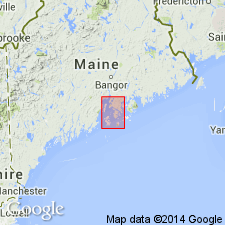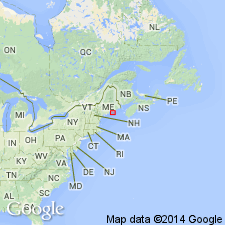
- Usage in publication:
-
- Calderwood's Neck schists
- Modifications:
-
- Named
- Dominant lithology:
-
- Slate
- Schist
- Quartzite
- AAPG geologic province:
-
- New England province
Summary:
Probably named for Calderwood's [Calderwood] Neck on Vinal Haven [Vinalhaven] Island, Knox Co., south-central coastal ME. Consists of dark quartzitic slates, banded schists (quartzose but varying in color and grain), and quite massive quartzites occurring on northeast part of the island. Felsitic rocks occur in close proximity to the granite and volcanic rocks and undoubtedly represent contact phases of Calderwood's Neck series. These are mottled or variegated, generally a light green. Age is probably older than Niagara.
Source: GNU records (USGS DDS-6; Reston GNULEX).

- Usage in publication:
-
- Calderwood formation*
- Modifications:
-
- Revised
- Age modified
- AAPG geologic province:
-
- New England province
Summary:
Name revised as Calderwood formation. Applied to all rocks described and mapped by Smith (1896) as Calderwood's Neck schists. Probably belongs to either the Islesboro or Penobscot formations, but its isolated position prevents certain correlation. Age is Cambrian(?).
Source: GNU records (USGS DDS-6; Reston GNULEX).

- Usage in publication:
-
- Calderwood Formation*
- Modifications:
-
- Age modified
- Geochronologic dating
- AAPG geologic province:
-
- New England province
Summary:
In this paper, the Calderwood is correlated with the Cranberry Island Series of Shaler (1889). The name Cranberry Island is used throughout the paper. Rb/Sr whole-rock isochron on the Cranberry is 387+/-9 Ma, which translates into Devonian age. Calcite-bearing samples can yield erroneous data, however; for instance, a calcite-bearing sample of Cranberry yielded a 368+/-33 Ma date.
Source: GNU records (USGS DDS-6; Reston GNULEX).
For more information, please contact Nancy Stamm, Geologic Names Committee Secretary.
Asterisk (*) indicates published by U.S. Geological Survey authors.
"No current usage" (†) implies that a name has been abandoned or has fallen into disuse. Former usage and, if known, replacement name given in parentheses ( ).
Slash (/) indicates name conflicts with nomenclatural guidelines (CSN, 1933; ACSN, 1961, 1970; NACSN, 1983, 2005, 2021). May be explained within brackets ([ ]).

